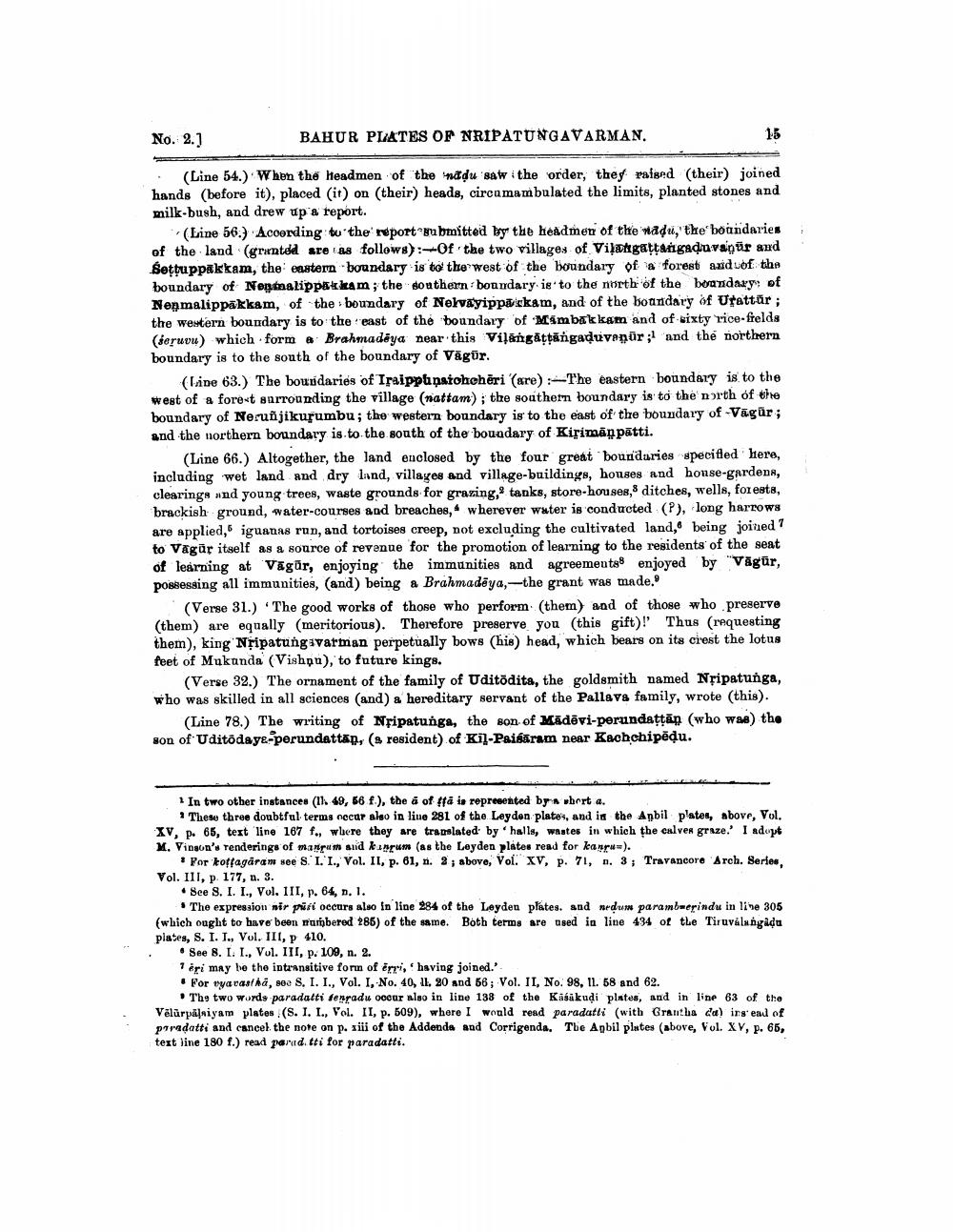________________
No. 2.)
BAHUR PLIATES OF NRIPATUNGAVARMAN.
15
. (Line 54.) When the Headmen of the nadu saw the order, they raised (their) joined hands (before it), placed (it) on (their) heads, circumambulated the limits, planted stones and milk-bush, and drew up a report.
(Line 56. According tu'the report submitted by the headmer of the wadu, the boundaries of the land (granted are as follows: Of the two villages of Vilagatta gaļuvalgür and Šetřuppakkam, the eastern boundary is to the west of the boundary of a forest and of the boundary of Neptalippakam; the southern boundary is to the north of the boandary: of Nenmalippakkam, of the boundary of Nelvayippackam, and of the boundary of Utattur ; the western boundary is to the east of the boundary of Mambakkam and of sixty rice-fields (sesuvu) which form a Brahmadaya near this Viļāngātāngaduvanur ;l and the northern boundary is to the south of the boundary of Vāgür.
(Line 63.) The bourdaries of Iraippuņaiohchēri (are) -The eastern boundary is to the west of a fore-t surrounding the village (nattam); the southern boundary is to the north of the boundary of Neruñjikurumbu; the western boundary is to the east of the boundary of Vāgür; and the northern boundary is to the south of the boundary of Kirimappatti.
(Line 66.) Altogether, the land enclosed by the four great boundaries specified here, including wet land and dry land, villages and village-buildings, houses and house-gardens, clearings and young trees, waste grounds for grazing, tanks, store-houses, ditches, wells, forests, brackish ground, water-courses and breaches, wherever water is conducted (P), long harrows are applied, iguanas run, and tortoises creep, not excluding the cultivated land, being joined ? to Vågür itself as a source of revenue for the promotion of learning to the residents of the seat of learning at Vāgūr, enjoying the immunities and agreements enjoyed by "Vägür, possessing all immunities, (and) being a Brahmadēya,--the grant was made.
(Verse 31.) The good works of those who perform (them) and of those who preserve (them) are equally (meritorious). Therefore preserve you (this gift)! Thus requesting them), king Nripatungavarman perpetually bows (his) head, which bears on its ciest the lotus feet of Mukunda (Vishọn), to future kings.
(Verse 32.) The ornament of the family of Uditõdita, the goldsmith named Nripatunga, who was skilled in all sciences (and) a hereditary servant of the Pallava family, wrote (this).
(Line 78.) The writing of Nripatunga, the son of Mādēvi-perundattāp (who was the son of Uditodaye-perundattan, (s resident) of Kil-Paisāram near Kachchipēdu.
* In two other instances (Ik. 49, 56 f.), the a of ffa is represented by whert a.
. These three doubtful terms nocar also in line 281 of the Leyden plates, and in the Anbil plates, above, Vol. XV, p. 65, text line 167 f., wliere they are translated by halls, wastes in which the calves graze.' I adopt M. Vingon's Tenderings of manum and kinrum (as the Leyden plates read for kayraw).
* Por koffagaran see 8. 'I.'I., Vol. II, p. 61, n. 3; above, Vol. XV, p. 71, n. 3; Travancore Arch. Series, Vol. II, p. 177, n. 3.
. See 8. I. I., Vol. III, p. 64, n. 1.
The expression sir print occurs also in line 284 of the Leyden plates, and nodum parambeenindu in line 305 (which ought to have been murbered 186) of the same. Both terms are used in line 434 of the Tiruválangada plates, S. I. T., Vol. III, P 410. • See 8. I. I., Vol. III, p. 109, n. 2.
Tari may be the intransitive for of erri, having joined. • Por vyavastha, see S. I. I., Vol. I, No. 40, L. 20 and 56; Vol. II, No. 98, 11. 58 and 62.
. The two words paradatti fenradu oceur also in line 138 of the Kibikudi plates, and in line 63 of the Valurpaniyam plates (S.I. L., Vol. II, p. 509), where I would read paradatk (with Grantha da) ins' end of paradatti and cancel the note on paill of the Addenda and Corrigenda. The Apbil plutes (above, Vol. XV, p. 66, text line 180 f.) read pard.tti for paradatli.




